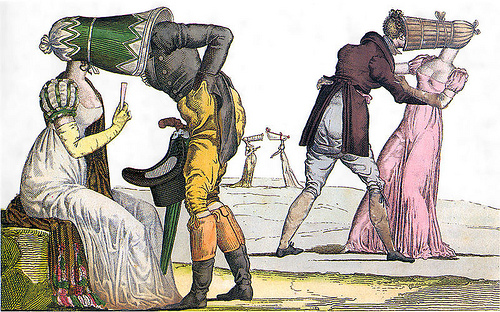You are here
Evaluating Satire With Rhetorical Analysis
Primary tabs

Tete-a-Tete provided by Lacy B Timeless via Flickr
This assignment asks students to locate a product ad on their computers, and evaluate its use of ethos, pathos, and logos given its goal and target audience. It then asks students to write or visually construct a brief parody of the advertisement, share it with the class, and explain their own use of ethos, pathos and logos in relation to their goal and audience.
This assignment has students evaluate a product advertisement using rhetorical analysis, construct working definitions of satire and parody, and experiement with writing and analyzing satires for their chosen ads. Ideally, these steps will help students solidify an understanding of ethos, logos and pathos, as well as attend to the wide range of genres using rhetoric to make arguments. The creative wring required introduces an engaging hook to keep students interested in the analytical process, and evaluating the success of their own satires helps them develop close-reading and peer-review skills.
They will first individually locate an ad (static image, audio or visual commercials, textual). If you have a technology-based classroom, you can have students conduct this step in class. If not, ask them to locate an ad ad bring in a copy or a detailed description of the video/ audio stream for homework. After finding an ad, students will write up an evaluation its use of ethos, logos, and pathos in relation to its goals and its target audience. This should take up one class period.
Next, discuss parody and satire with your students. I showed a makeup commercial followed by a commercial parody. We discussed how each used ethos, logos, and pathos to achieve its distinct goals and to relate to its target audience.
Next, ask students to type up or construct a visual parody of their selected ad. Since students can get overenthusiastic about using visual software, I asked them to use only thirty minutes of class time to accomplish this goal instead of assigning it for homework, but it could easily be achieved on their own.
Finally, have students trade parodies and evaluate the use of ethos, logos and pathos in their classmate's parody. Have them construct a brief thesis statement about whether or not the use of rhetoric accomplished the satire's goal in relation to the target audience.
Decide which steps should be conduct inside and outside of class. I had my students perform each step in class because I was in a technology-based classroom, but asking them to bring in ads for homework would enable students to explore print materials as well as web sources. I also had my students develop their creative satire projects in class, but this could easily be accomplished at home.
Before this assignment, students should be familiar with rhetorical analysis, have been introduced to ethos, logos, and pathos, and have a working understanding of how to construct a thesis based on source goals and audience. This assignment can be stretched out for multiple class periods depending on how much outside work you ask them to bring to class.
1) Have students locate or bring to class an advertisement.
2) Ask students to list incidents of the use of ethos, logos and pathos in the ad, then construct a thesis: Does the ad successfully accomplish its goals in relation to its audience using rhetoric? Why or why not?
3) For the next class, introduce students to satire and parody. I showed several videos to familiarize my students with the concept, but there are many sources of satire that could be used. As a group, discuss how your chose satire uses rhetoric to influence its audience and accomplish its goals.
4) Either as homework or in class, have your students construct a parody of their chosen ad. I gave my students the option to draw their parody by hand or pull images from Flickr and doctor them in Photoshop.
5) Finally, have the students exhange parodies and perform a rhetorical analysis of their classmate's work. Ask volunteers to share parodies and evaluations.
I used this assignment in Rhetoric 306, an introduction to rhetoric course.
-

- Log in to post comments

